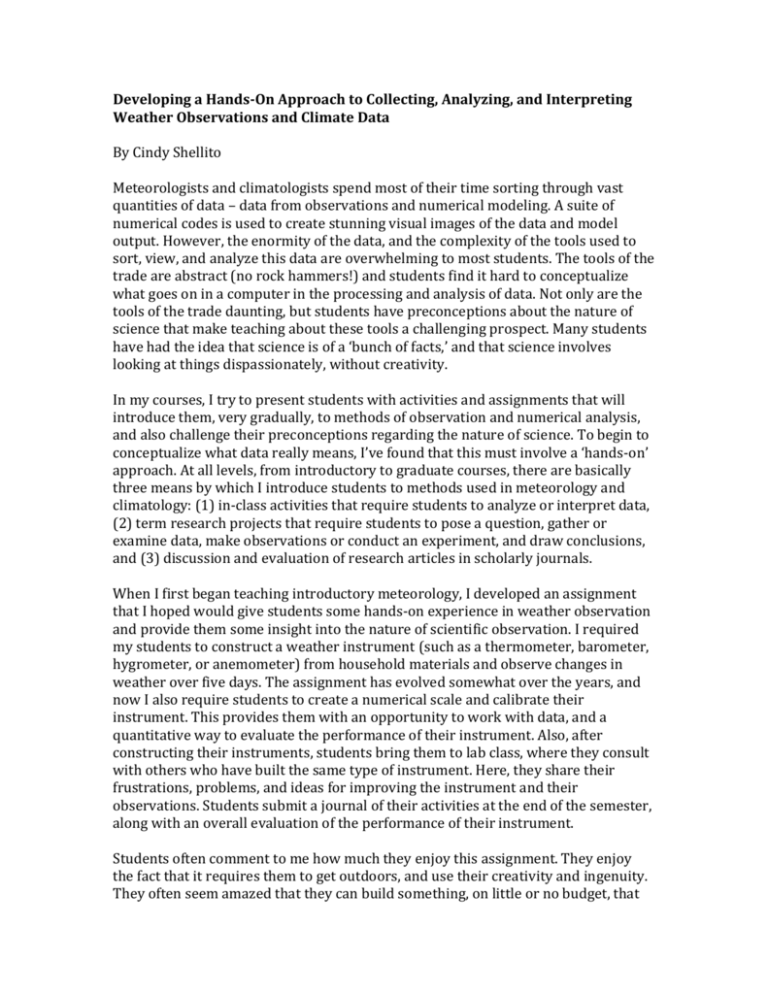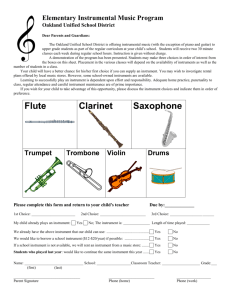Developing a Hands-On Approach to Collecting, Analyzing, and
advertisement

Developing a Hands-On Approach to Collecting, Analyzing, and Interpreting Weather Observations and Climate Data By Cindy Shellito Meteorologists and climatologists spend most of their time sorting through vast quantities of data – data from observations and numerical modeling. A suite of numerical codes is used to create stunning visual images of the data and model output. However, the enormity of the data, and the complexity of the tools used to sort, view, and analyze this data are overwhelming to most students. The tools of the trade are abstract (no rock hammers!) and students find it hard to conceptualize what goes on in a computer in the processing and analysis of data. Not only are the tools of the trade daunting, but students have preconceptions about the nature of science that make teaching about these tools a challenging prospect. Many students have had the idea that science is of a ‘bunch of facts,’ and that science involves looking at things dispassionately, without creativity. In my courses, I try to present students with activities and assignments that will introduce them, very gradually, to methods of observation and numerical analysis, and also challenge their preconceptions regarding the nature of science. To begin to conceptualize what data really means, I’ve found that this must involve a ‘hands-on’ approach. At all levels, from introductory to graduate courses, there are basically three means by which I introduce students to methods used in meteorology and climatology: (1) in-class activities that require students to analyze or interpret data, (2) term research projects that require students to pose a question, gather or examine data, make observations or conduct an experiment, and draw conclusions, and (3) discussion and evaluation of research articles in scholarly journals. When I first began teaching introductory meteorology, I developed an assignment that I hoped would give students some hands-on experience in weather observation and provide them some insight into the nature of scientific observation. I required my students to construct a weather instrument (such as a thermometer, barometer, hygrometer, or anemometer) from household materials and observe changes in weather over five days. The assignment has evolved somewhat over the years, and now I also require students to create a numerical scale and calibrate their instrument. This provides them with an opportunity to work with data, and a quantitative way to evaluate the performance of their instrument. Also, after constructing their instruments, students bring them to lab class, where they consult with others who have built the same type of instrument. Here, they share their frustrations, problems, and ideas for improving the instrument and their observations. Students submit a journal of their activities at the end of the semester, along with an overall evaluation of the performance of their instrument. Students often comment to me how much they enjoy this assignment. They enjoy the fact that it requires them to get outdoors, and use their creativity and ingenuity. They often seem amazed that they can build something, on little or no budget, that will quantify changes in the atmosphere. They also learn how difficult it is to create an instrument that measures something consistently. They realize that sometimes there is more than one way to build an instrument, and that design considerations will tie in closely with consistency and accuracy of their instruments. They learn about the nature of uncertainty when they conduct an analysis of their data, and they learn about the value of sharing ideas with their peers to improve the design of their instrument. This assignment requires students to integrate things they have learned in lecture and lab, and apply it in a new way, and for that, I have been really happy with it. In my upper division courses, I teach students who are majoring in meteorology and environmental science. In order to best prepare for the job market, these students must become familiar with handling larger quantities of data. As a climate modeler, most of my emphasis in these courses is on using numerical models to provide insight regarding factors that affect climate. I begin by introducing students to the simplest of numerical models first. I usually have them conduct a short, in-class ‘research’ project using Excel spreadsheet to calculate global temperature based on variations in climate forcing parameters. In my Paleoclimatology course, this practice with Excel leads into a term project where they must either use a simple numerical climate model or complete an analysis and comparison of climate data available online (e.g., comparing two data sets, or two different types of proxy data). In an upper division Climatology course, students must complete a full research project investigating some aspect of the climate system with a low-resolution 3-D global climate model. Students are sometimes overwhelmed by both the limitations of the model, and at the same time, by the enormity of model output, but they learn to focus their model analysis on the parameters that will provide the best answer to their question. I’ve had alumni tell me that they have used some of the computational skills in their work. Students who go on to become teachers have adapted some of my assignments in their classes. Through these assignments and projects, my goal has been to encourage students to develop skills that will be applicable in many different types of work environments. While I realize that the content of my courses in important, I hope to instill in my students a way of scientific thinking and problem solving that will last a lifetime.






